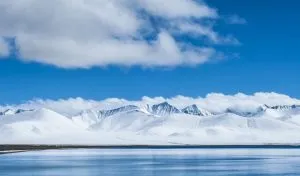A tundra is a cold region that does not warm above 10°C during summer. When we think of tundra, the arctic tundra is usually the first thing that comes to mind. But there are also alpine tundra which are slightly different.
So, what’s the difference between arctic tundra and alpine tundra?
The arctic tundra is a specific region that covers the northernmost parts of the world from the north pole and extending south, whereas alpine tundra are found across the world at high altitudes. Examples of alpine tundra include Mount Fuji (Japan), Mount Washington (US), and Ben Nevis (UK).
Whilst arctic and alpine tundra are linked by their average monthly temperatures, there are many differences between the two which we’ll look at in detail below.
What is a Tundra?
The first thing we’ll consider is how a tundra is defined. Under the widely used Köppen climate system, a tundra is defined as a region where the temperature of the warmest month is between 0 – 10°C.
Whilst this system groups all tundra together, an alternative classification from the University of California, Berkley breaks down tundra into two distinct types:
- Arctic tundra
- Alpine tundra
Alpine vs Arctic Tundra
The main difference between arctic and alpine tundra is where they are found.
The arctic tundra is only found in the northernmost parts of the world.
The arctic is located from the north pole and extending further south to the treeline across North America and Eurasia. Much of this is sea, but the parts over land are mostly tundra.
Alpine tundra can be found anywhere on Earth, although they are at high altitudes of 10,000 feet and above. Alpine tundra covers around 3% of the Earth’s surface1 (source: Mountain Biodiversity, its Causes and Function: an Overview, C. Körner, 2002).
There are examples of mountain ranges with alpine tundra across every continent such as the Rocky Mountains (North America), the Andes (South America), the Himalayas (Asia), the Rift Mountains (Africa), and the Alps (Europe).
Some of the most well-known alpine tundra include:
- Ben Nevis, Scotland, United Kingdom
- Cerro de Pasco, Peru
- Mount Fuji, Japan
- Mount Washington, New Hampshire, United States
- Mount Wellington, Tasmania, Australia
- Murghab, Tajikistan
- Zugspitze, Bavaria, Germany
Arctic and alpine tundra are oftentimes referred to as wet (arctic) and dry tundra (alpine), this is because alpine tundra has much better soil drainage, but more on this later.
Similarities and Differences Between the Arctic and Alpine Tundra
Location isn’t the only thing that sets arctic and alpine tundra apart, here is a look at the main similarities and differences of these two types of biome:
Similarities
Let’s first begin with the things that all tundra have in common:
1. Soil is similar in the arctic and alpine tundra with a layer of permafrost
A key feature of any tundra is the soil. Both arctic and alpine tundra have a layer of active soil that thaws in the summer to allow plants to grow. Below this is permafrost which remains frozen year-round.
When plants die, their nutrients can’t drain through the soil as they normally would due to the frozen layer underneath, instead they create a nutrient pool.
Any plants in these regions need to be able to survive on few nutrients.
2. Vegetation is limited to low growing vegetation
This leads us on nicely to vegetation which is similar in both arctic and alpine tundra.
The layer of permafrost below the surface means that tree roots cannot take hold so they are largely treeless environments.
Instead, low-growing vegetation such as lichen, mosses, and shrubs thrive in these regions during the growing season. This vegetation is well adapted to the harsh conditions found at high altitudes.
These plants are under threat due to climate change which is seeing a reduction in alpine tundra and could result in the extinction of these species2 (source: Environmental Research Letters, C. Dumais, et al, Vol 9, No. 9, 2014).
Differences
Now, let’s run through the remaining differences between arctic and alpine tundra (excluding location which has been mentioned earlier):
1. Winter temperatures are colder in the arctic tundra
By their nature, all tundra have a similar temperature during their warmest months.
Average summer temperatures in a tundra biome will peak between 0 – 10°C degrees. This allows the top layer of soil to thaw and let’s vegetation grow.
However, the winter temperatures are much more severe in the arctic tundra than alpine tundra.
In the arctic tundra, winter temperatures can drop as low as –32°C (–25°F) whereas alpine tundra do not usually fall below –18°C (0°F)3 (source: Britannica).
2. Rain and snowfall is higher in alpine tundra
Although there are some parts of the arctic that receive high levels of rainfall (e.g. Greenland), most of the arctic tundra receives annual precipitation of around 150-250mm (6-10″)4 (source: University of California Museum of Paleontology) which is enough to classify it as a desert.
Conversely, alpine tundra experience more rainfall and there is a greater amount of variety between different alpine tundra regions. These regions will typically experience between 840-1020mm (33-40″) per year5 (source: Sciencing).
However, increased humidity allows the rainfall to evaporate more quickly than the arctic tundra and there is much better soil drainage as we’ll discuss shortly.
3. The growing season is shorter in the arctic tundra
Whilst all tundra have similar vegetation, the growing season is very different between alpine and arctic tundra. The arctic tundra has longer, colder winters.
Vegetation has a much shorter period to sustain itself in the arctic with a growing season of 50 to 60 days, this is compared to around 180 days in alpine tundra.
However, climate change is having a drastic effect on the growing season in the arctic with ice melting earlier than usual. This could increase the growing season by as much as 40% by the middle of this century6 (source: Arctic, Antarctic, and Alpine Research, G. Starr, et al, Vol 40, Issue 1, 2008).
This lengthened growing season will impact the types of vegetation that can thrive in the arctic tundra and will have consequences for the entire ecosystem.
4. The soil drains much better in alpine tundra
Another key difference between the arctic and alpine tundra is the soil drainage.
The arctic tundra has very poor drainage because of the layer of permafrost that lies beneath the surface. Even in the summer months, this does not thaw so water cannot drain away.
Given that large parts of the arctic tundra are desert, this is beneficial as it allows bogs and ponds to form which can help sustain vegetation.
Conversely, alpine tundra are well equipped for drainage due to the incline of the land that allows it to run down. The soil is usually thin and dry.
5. Both biomes attract different animals
One final key difference between arctic and alpine tundra is the animals that can be found there.
Although the arctic tundra is spread across several continents, the species found there are fairly consistent. Examples include lemming, arctic hare, arctic fox, polar bear, musk ox, and caribou.
However, the alpine tundra is different because there are no animal species common to all alpine tundra. For example, yellow-bellied marmots can be found in alpine tundra of North America but not other continents.
Other animals that can be found in alpine tundra across the world include mountain goats, sheep, elk, and more.


![You are currently viewing Arctic Tundra vs Alpine Tundra [7 Similarities and Differences]](https://polarguidebook.com/wp-content/uploads/2021/08/Arctic-tundra-vs-alpine-tundra.jpg)

![Read more about the article Is the Arctic a Desert or Tundra? [Both – Here’s Why]](https://polarguidebook.com/wp-content/uploads/2021/07/Is-the-arctic-a-tundra-or-desert-300x176.jpg)
